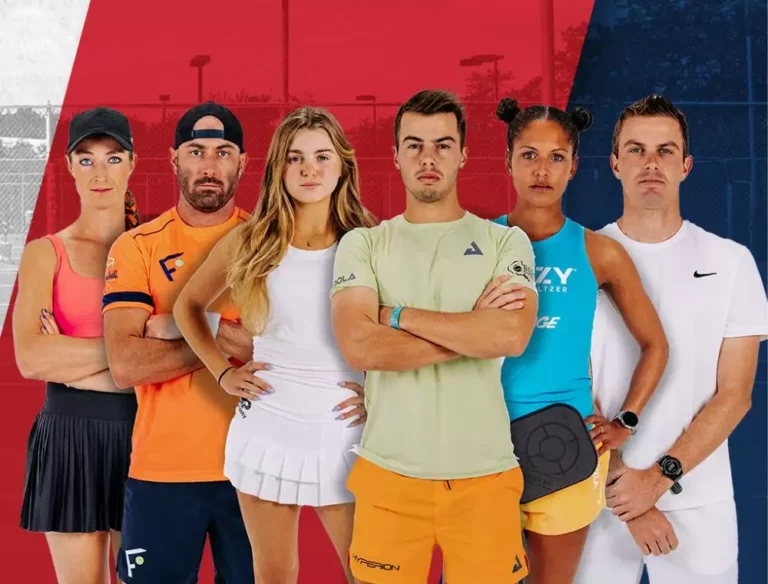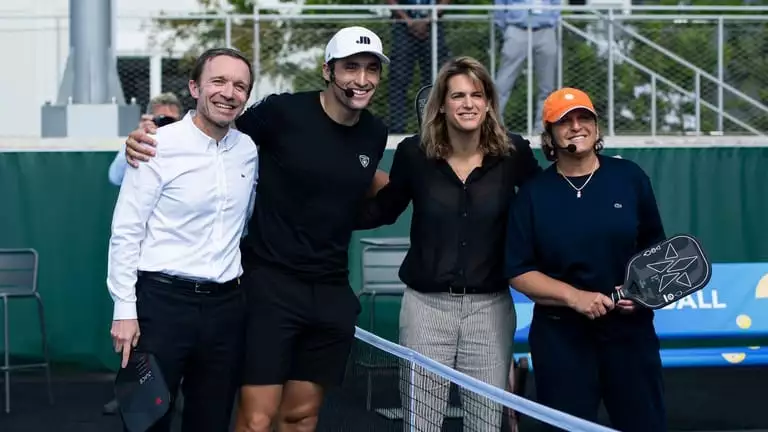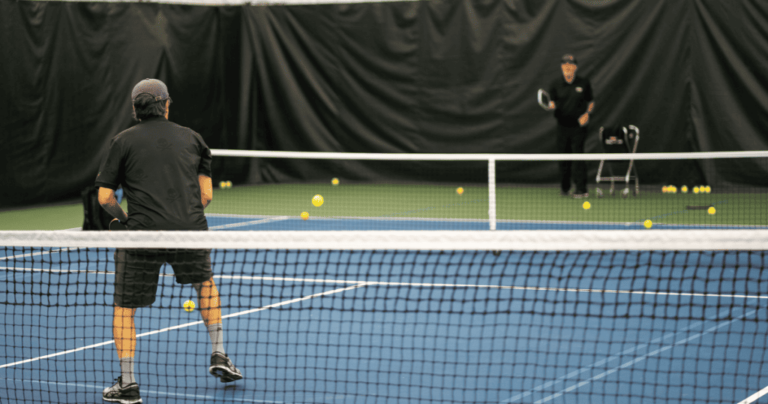How Much Do Pro Pickleball Players Make? Earnings Revealed
Professional pickleball has exploded in popularity over recent years, transcending from a niche sport to a mainstream phenomenon enjoyed by millions. With its rising status comes the question of earnings – how much do these athletes actually take home? As with any sport, the income of pro pickleball players isn’t straightforward; it varies widely based on factors such as tournament performance, sponsorship deals, and individual marketability. This detailed examination will delve into the earnings landscape of professional pickleball players, offering insights into median incomes, potential earnings for top players, and how these figures stand when compared to those of athletes in other sports.

As of 2024, the median annual income for professional pickleball players hovers around $112,707, while the average hourly wage is approximately $54.19. However, this figure masks the income disparity evident within the sport. For instance, the lower quartile may earn as little as $30,000 annually, while top-tier athletes can bring in over $1 million through various income channels. This complexity illustrates not just the growth of pickleball as a sport, but also the financial opportunities available to those willing to invest in their game and brand.
In the following sections, we will explore the income sources for these athletes, breaking down the various streams that contribute to their financial well-being, including tournament prizes, sponsorships, coaching, and the overarching factors driving their earnings potential.
How Much Do Pro Pickleball Players Make?
The earnings of professional pickleball players can be characterized by a broad spectrum, which reflects varying levels of achievement and marketability. The monetary landscape for these athletes has significantly evolved, particularly with the establishment of competitive leagues, such as the Professional Pickleball Association (PPA) and Major League Pickleball (MLP).

- Median Income: As previously mentioned, the median annual income for professional pickleball players stands at approximately $112,707. This median reflects a variety of player experiences, from those new to the sport to seasoned veterans.
- Income Range: Statistical data indicates that professional players can earn anywhere from $20,000 to more than $250,000 year, depending on their engagement level and effectiveness in securing sponsors.
- Awards and Prize Money: In tournaments governed by PPA, the average annual earnings per player were about $96,000 as of 2022. The lucrative prize pools are instrumental in this respect, with top players potentially amassing substantial rewards for their skill, commitment, and consistency on the court.
- Additional Sources of Income: Furthermore, alongside prizes from wins, many professional players supplement their incomes through sponsorships, endorsements, and coaching opportunities. Notable figures demonstrate that elite players can earn exit payouts that far exceed basic tournament winnings, thereby diversifying their revenue streams effectively.
This overview indicates that while median income provides a baseline understanding of player earnings, individual financial success is often determined by players’ skills, branding, and strategic management of their careers. With the sport’s rising popularity, the potential for increased earnings continues to grow, presenting exciting opportunities for both current and aspiring professional pickleball players.
Median Income of Professional Players
Delving deeper into the specifics of a professional pickleball player’s income, the median annual earnings provide a crucial insight into the financial landscape of the sport. The $112,707 figure might seem significant, but it is essential to dissect what it represents in the context of a sport still carving its niche. Many athletes find that the median income is composed of several layers of revenue, derived largely from tournament success and ongoing sponsorship relationships.
- Comparison with National Averages: To contextualize this figure, consider that the median annual salary for all U.S. workers is approximately $54,000. In this sense, professional pickleball players are indeed positioned well above average. However, earnings are not uniform. Newer players may struggle financially, taking home just a fraction of the median income until they build their reputation in the sport.
- Success Stories: The income potential is illustrated vividly through the careers of high-performing athletes such as Ben Johns and Simone Jardim, who have amassed impressive incomes through outstanding competitions and savvy handling of endorsement deals. This success translates into monetary rewards as opposed to the sporadic nature of tournament prize money, demonstrating factors like reputation and past performance are integral to maximizing earnings potential.
- Understanding Variability: The fluctuating nature of these earnings serves as a metaphorical roller coaster ride. Much like the unpredictable bounce of a pickleball, player income oscillates based on wins, losses, and the potential for lucrative contracts. For talented players, an exceptional season can catalyze a sharp increase in their income. However, failure to maintain top performance can lead to a significant downturn in earnings.
- Bottom Line: Overall, while the median income of roughly $112,707 paints a picture of a prosperous community of athletes, this number is accompanied by vast variability among player experiences. For up-and-coming players, the road to financial stability can be daunting, but for those at the top of the pack, the financial rewards can indeed be life-changing.
Income Range of Top Earners
Exploring the upper tiers of income among professional pickleball players reveals a stark contrast between those at the peak of manifestation and the median or lower earners. The income range for top earners is where you can witness the financial possibilities for professionally engaged players, especially those who have gained substantial fame within the sport.
- Elite Earnings: Top players can earn as much as $1 million annually. The remarkable difference in income levels can be attributed to factors such as tournament success, personal branding, and the securing of high-value sponsorship deals. For instance, Ben Johns’s rise to prominence has seen him reportedly earn $2.5 million per year through combined earnings from competitions and brand partnerships.
- Source Breakdown: An analysis of earnings distribution among the top finishers in tournaments shows that those players typically earn substantial sums from prize money, sometimes exceeding $300,000 for a single tournament under the PPA umbrella. The majority of their income, however, derives from lucrative sponsorship deals with companies eager to align with successful athletes.
- Sponsorship Significance: Sponsorships illustrate a pivotal source of income, with endorsement deals increasingly representing a major financial lifeline for professional players. For exceptional athletes, it is possible for sponsorships to compensate for tournament winnings entirely. This demonstrates the increased importance of building a personal brand in the modern sports market.
- Economic Implications: Understanding the income range of top earners portrays the vast financial opportunities awaiting successful professional players. As the sport continues to maintain its trajectory of popularity, such disparities in earnings are likely to encourage increased competition and investment in personal branding strategies – a burgeoning trend for players looking to capitalize on the pickleball phenomenon.
Comparison with Other Sports
To truly appreciate the earnings landscape of professional pickleball players, it’s important to juxtapose their financial success with that of athletes from more established sports. The comparison displays not only stark variations in income but also insights into how the evolving landscape of sports may affect future earning potential for pickleball professionals.

- Baseball and Basketball Examples: Comparing pickleball to Major League Baseball (MLB) or the National Basketball Association (NBA) is akin to comparing apples to oranges. The average MLB player earns roughly $4 million per year, while NBA players average about $9 million annually. This stark contrast highlights the financial chasm faced by players in non-mainstream sports.
- Tennis and Golf: When evaluating professional tennis, top athletes like Roger Federer and Serena Williams command incomes that reach into the hundreds of millions thanks to a combination of tournament earnings and endorsement deals. Golfers can achieve similar heights, where top competitors can earn well over $50 million in a single year from endorsements alone.
- Pickleball’s Growth Trajectory: Though the salaries and earnings of pickleball players similarly boast potential for growth, there’s still a considerable distance to close with mainstream sports. This comparison subtly hints at the potential for increased exposure and financial opportunities as pickleball’s prominence continues to grow.
- Shifting Paradigms: It’s vital for aspiring professional players to consider their income potential associated with association-type sports. Understandably, pickleball as a sport is still molding its identity and brand recognition and is likelier to attract lower earnings in the short-term, while future growth promises more favorable economic prospects approaching those of established sports.
Sources of Income for Pro Pickleball Players
Understanding the sources of income for professional pickleball players reveals how they navigate earnings from various streams and optimize their revenue potential.

- Tournament Prize Money: The bulk of income for many players still stems from tournament prize money. High-stakes events draw talented competitors, and as prize pools grow, they present enticing income prospects. The PPA’s total prize distribution of approximately $5.5 million in various events highlights a significant incentive for many athletes.
- Sponsorships and Endorsements: As the sport garners attention, so does the possibility of lucrative sponsorship arrangements. Brand partnerships can provide substantial financial support, often exceeding earnings from competitions. Being affiliated with respected brands like Wilson or Adidas enhances not just income, but also marketability.
- Coaching and Clinics: Many players supplement their tournament winnings by providing lessons, hosting clinics, and offering personalized coaching services. This income avenue offers flexibility, allowing players to expand their financial portfolio without relying solely on competition.
- Digital Presence: Building a robust online presence via platforms like YouTube and Instagram can lead to additional revenue through ad placements and promotional deals. Engaging with fans online increases a player’s marketability, making them more appealing to potential sponsors.
- Merchandising: Players can leverage their popularity in the sport by creating and selling branded merchandise, further enhancing their earning opportunities while promoting the sport itself.
By understanding these various income sources, it becomes evident that the landscape for professional pickleball is an evolving marketplace of opportunity, inviting both current and aspiring players to capitalize on its potential.
Tournament Prize Money
Tournament prize money remains a primary source of income for professional pickleball players, and its distribution plays a significant role in their overall earnings.
- Prize Pool Diversity: As the sport matures, tournaments are increasingly establishing larger prize pools, with major competitions offering impressive payouts. In 2023, the total prize pool across events hosted by the PPA was reported to surpass $5.5 million, emphasizing the financial growth within the sport.
- Top Events and Prize Distribution: Certain prominent tournaments now feature substantial prize allocations. For example, the USA National Pickleball Championship offers a total prize pool of $100,000, with significant financial rewards awaiting both singles and doubles champions.
- Competing for Earnings: Individual athletes face the opportunity to win major prizes frequently, with those at or near the top of their respective brackets reaping generous rewards for their consistent performance. As the sport’s competitive nature serves to attract a diverse gathering of top players, the stakes continue to evolve.
- Income Spectrum: Players competing in prestigious tournaments can earn between $20,000 and $250,000 or more through a combination of prize money and sponsorships. The variability of this income requires players to remain competitive and maintain favorable conditions to thrive.
Sponsorships and Endorsements
Sponsorships and endorsements represent a significant avenue for income enhancement among professional pickleball players. As the sport continues to gather momentum, these financial arrangements reward skilled athletes who can successfully market themselves and attract brand partnerships.
- Diversity of Sponsorship Deals: Various forms of sponsorship opportunities exist, including endorsements from equipment manufacturers, apparel brands, and health products. Specific relationships typically range from receiving monetary compensation to gaining free equipment.
- Lucrative Returns: Well-established players can earn substantial amounts through these sponsorships, with some athletes reported to secure endorsement deals worth upwards of $150,000 annually. This financial security enables players to focus on performance while also maximizing their income potential.
- Visibility Matters: Sponsorship opportunities hinge on a player’s visibility and marketability in the sport. High-performing athletes attract more lucrative deals, as brands seek individuals who can elevate their visibility in the rapidly expanding pickleball community.
- Long-Term Relationships: Building lasting partnerships with these brands demonstrates a mutually beneficial relationship. Players secure financial stability while brands improve their product exposure by aligning with recognized figures in the sport.
Appearance Fees and Contract Minimums
Another crucial factor in pro pickleball player income is the concept of appearance fees and contract minimums, providing athletes with guaranteed financial support irrespective of their performances.
- Guaranteed Income: Certain professional players negotiate contracts that include guaranteed minimum payments for attending events, which can help shield them from any potential financial setbacks associated with unsuccessful tournaments.
- Fee Variability: Appearance fees can vary widely, generally contingent upon the player’s marketability and standing in the sport. An athlete with a significant following may command a higher fee than emerging players.
- Financial Stability: This model presents a safety net within the volatile world of sports, affording professionalism and providing reliable support as players strive to achieve their peak performance.
- Income Spectrum: Including these factors in a financial overview paints a clear picture of a player’s potential income. For example, successful players can combine endorsement earnings, tournament victories, and guaranteed fees into a cohesive income strategy.
Coaching and Clinics
Coaching and clinics present another substantial opportunity for professional pickleball players to bolster their incomes and provide community engagement.
- Personalized Training: Players can offer private coaching sessions, providing tailored instruction to individuals or small groups looking to improve their skills. Many-renowned players leverage their expertise to charge significant fees for these sessions.
- Group Clinics: Organizing clinics allows players to teach larger groups, which can lead to lucrative income opportunities, especially during peak interest times. These sessions can range in focus, from technique refinement to comprehensive strategy sessions.
- Broader Outreach: Online coaching presents a particularly advantageous method for players to reach a broader audience while enhancing income potential. Digital programs can be marketed around existing training material, enabling connection beyond geographical constraints.
- Community Impact: By conducting clinics and workshops, players contribute to the sport’s growth and foster a deeper connection to their fans, enhancing their own marketability while sharing their passion for pickleball.
Factors Influencing Income Levels
Multiple factors can significantly influence how much professional pickleball players earn, highlighting the multifaceted nature of earnings in this sport.

- Performance in Tournaments: Athletes who finish in higher placements can secure inviting prize money, enhancing their income levels. Success can translate into not only immediate financial rewards but also long-term benefits related to sponsorship opportunities and visibility.
- Sponsorship and Endorsements: Player reputations significantly impact their appeal to sponsors, thereby influencing their overall income. Engaging with high-profile brands emerges as a critical pathway to financial security for promising athletes in pickleball.
- Contract Minimums and Appearance Fees: Many players who secure contracts with leagues benefit from guaranteed payments to bolster their income. These fees serve to foster financial stability amid the often uncertain nature of tournament results.
- Market Demand: As pickleball continues rising in popularity, the demand for coaching, clinics, and community events allows players to seize new revenue streams. Increased interest results from community engagement and participation in clinics and training.
- Geographical Location: Earnings potential can greatly vary depending on where players reside. Regions with more concentrated pickleball communities or frequent tournaments provide more opportunities for earning.
- Skill and Recognition: Recognition plays an essential role in income potential. Prominent players who build impressive portfolios through accolades often see increased demand for coaching and endorsement opportunities.
Player Performance and Ranking
Player performance serves as a critical determinant in their earnings potential, directly correlating with prize money and sponsorship opportunities. Ranking systems established by organizations like the Professional Pickleball Association (PPA) spotlight the importance of competitive standing.
- Performance Metrics: Recognition in tournaments significantly influences earnings. Higher-ranking, better performers often gain superior access to lucrative sponsorships and higher payout potentials.
- Long-Term Implications: A player’s success not only leads to immediate financial rewards but also impacts their long-term marketability and ability to secure better contracts and appearance fees in the future.
- Benchmarking Success: Performance metrics are fundamental; data shows that elite PPA players typically attracted prize values much higher than their counterparts. Consequently, top-tier players separate themselves from the pack.
- Career Impacts: Ultimately, continuous high-level performance serves as a powerful catalyst for effectively building brand partnerships and attracting lucrative market opportunities – testament to the intersection of skill and market dynamics in professional pickleball.
Marketability and Brand Association
The significance of marketability and brand association cannot be understated when considering professional pickleball earnings, as personal branding plays a pivotal role in revenue generation.
- Creating Influence: Players with strong social media presence and authentic engagement can attract lucrative sponsorships and endorsement deals. Marketability depends on how effectively players can connect with their audience across platforms.
- Brand Alignment: A player’s marketability is essential; brands interested in reaching potential customers are more inclined to partner with recognized athletes who embody their ethos and appeal to specific demographics.
- Financial Dynamics: High-performing players can simultaneously build a powerful brand which translates to significant endorsements. Marketable athletes typically command higher financial returns.
- Growing Recognition: Success in both competitions and effective brand management enhances visibility, ensuring players can successfully navigate an evolving marketplace.
Growth of the Sport and Fan Engagement
The dramatic upsurge in pickleball’s popularity illustrates how crucial fan engagement is to enhancing professional players’ income potential. A growing fanbase equates to increased visibility and various financial opportunities.
- Participatory Growth: With over 4.8 million players in the U.S. by 2021, the sport has witnessed an impressive growth trajectory, which significantly enhances players’ income levels as interest mounts.
- Financial Viability: Increased engagement strengthens financial opportunities on multiple fronts, as organizations invest heavily in tournament prize money, sponsorship, and marketing initiatives.
- Player-Fan Connection: Building a rapport with fans through social media and promotional events is crucial, as successful athletes leverage their following to secure sponsorships and wider brand visibility.
- Future Aspirations: As pickleball maintains its rising trajectory, the potential for increased earnings will empower athletes to develop sustained careers, pivoting away from the traditional models of sports earning and partnership strategy.
Impacts of Sponsorship on Earnings
Sponsorship represents a significant piece of a professional pickleball player’s financial puzzle, with brand arrangements filling the gaps where tournament earnings may fall short.

- Types of Sponsorship Deals: Various categories of sponsorship exist, such as equipment brands, apparel companies, and health-focused brands. These arrangements can significantly boost players’ earnings, with some agreements reaching six-figure sums.
- Exposure and Visibility: High-profile players often command sponsorships that provide not just financial support but attractive perks like free gear and promotional opportunities, further entrenching them in the public eye.
- Long-Term Collaborations: Establishing sustainable relationships benefits both brands and players. Effective partnerships enhance brand visibility while providing players with reliable financial support.
- Financial Influx: As the popularity of pickleball escalates, the number of available sponsorship opportunities is likely to grow, thereby improving the overall earning environment for professional players.
Types of Sponsorship Deals
Examining the types of sponsorship deals available to professional pickleball players illuminates the pathways through which they can enhance their earnings and reputation.
- Equipment Sponsorships: Many pro players partner with brands that offer paddles, balls, and other gear, reaping financial compensation or receiving free equipment in return for their promotional efforts.
- Apparel Sponsorships: Similar deals exist with sports apparel brands, where players wear and promote clothing during both matches and public appearances, often translating to substantial income based on their reach.
- Health and Wellness Deals: Players often sign with brands focused on nutrition, supplements, and fitness, aligning with their values and interests while providing financial rewards.
- Event Sponsorships: High-profile players may receive payments for attending specific events or participating in exhibitions, allowing them to earn guaranteed fees just for their presence at various tournaments.
- Multi-Channel Sponsorships: Brands are increasingly exploring partnerships that encompass digital platforms, engaging players in promotional initiatives across social media, ads, and influencer campaigns.
Role of Social Media in Attracting Sponsors
The emergence of social media has transformed how pro pickleball players can secure sponsorships, leverage their earnings, and engage with fans.
- Building a Personal Brand: Players who develop strong personal brands and undertake creative initiatives can attract lucrative sponsorship deals, showcasing their skills and personality through engaging content.
- Engagement Metrics: Brands look for players with high follower counts and active engagement rates. Successful partnerships generate valuable marketing reach, further bolstering player incomes.
- Content Creation: Actively producing various types of content tutorials, match highlights, personal stories allows athletes to capture viewers’ attention and strengthen sponsor relationships.
- Collaborative Opportunities: Engaging with other influencers or brands also diversifies revenue-generating avenues, creating mutually beneficial partnerships that enhance visibility and sponsorship prospects.
Case Studies of High-Earning Players
High-earning athletes in professional pickleball illustrate the multitude of avenues available for those who excel both on the court and in their marketing efforts.
- Ben Johns: Renowned for his dominance on the paddle court, Ben Johns sets the standard for earnings potential. His reported income exceeds $2.5 million annually through tournament winnings, sponsorships, and brand partnerships, demonstrating the financial possibilities that come with elite performance.
- Tyson McGuffin: McGuffin exemplifies how top athletes can build brand loyalty outside their competitive achievements. His ability to engage community members and drive engagement through clinics reflects broader themes in how players can monetize their skills.
- The Rise of New Players: Emerging players are capitalizing on strategic branding and intelligent marketing initiatives, positioning themselves as future stars while developing the necessary acumen to sustain growth in earnings as the sport expands.
Summing up, these case studies signify not only impressive personal achievements but also articulate larger trends in sponsorship and income potential, showcasing how high-performing players pave the way for the next generation while enhancing their earning capacities.
Prize Money Distribution in Major Tournaments
Prize money distribution in professional pickleball reflects the sport’s increasing advancements and growing competitive stakes among athletes.
- Tournament Organizers: Both the PPA and MLP have played pivotal roles in boosting prize payouts, which attract top competitors while also drawing interest from sponsors.
- Prize Pool Examples: Individual tournaments across the spectrum offer varied prize allocations, with events like the USA National Pickleball Championship featuring a $100,000 purse, indicating the growing financial appetite within the sport.
- Financial Opportunities: Players are presented with ample opportunities to earn substantial payouts from finishing at or near the top. This range of income illustrates the economic potential available, especially when driven by improved infrastructure and fan engagement.
- Ongoing Trends: The trends in increasing prize money suggest promising opportunities for professionalism within pickleball as it continues to develop as a sport, ensuring that players can build financially rewarding careers through their achievements.
Prize Pools in PPA and MLP Events
Analyzing the prize pools offered in PPA and MLP events illustrates how these tournaments are quickly rising in prominence and competition.
- Rewarding Performance: In 2023, the PPA allocated $5.5 million in prize money across its events, highlighting both the financial viability and growth potential of the sport.
- MLP Contributions: The MLP, similarly, is realizing investment worth approximately $2.4 million for its events, representing a significant boost from prior seasons, thus demonstrating the financial support emerging as the sport continues gaining ground.
- Targeted Prize Distribution: Both tour organizations may define prizes based upon performance; for example, not only will top finishers earn substantial amounts, but deeper distributions can reward additional placements, stimulating a healthy competitive landscape.
- Future Considerations: With both leagues committed to continual prize increases, the financial outlooks for professional pickleball players appear particularly promising, especially as the sport evolves and garners further media and competitive exposure.
Breakdown of Prize Money by Tournament
A meticulous breakdown of prize money by specific tournaments sheds light on notable disparities in income, ensuring players can compete for considerable earnings based on competitive stakes.
- PPA Event Examples: For instance, specific identifiable events might generate diverse prize pools, such as:
- Atlanta: $65,000
- Southern California: $65,000
- Pro Players Cup: $38,250
- Other embarked competitions can offer upward of $100,000, showcasing substantial financial rewards.
- MLP Prize Distribution: The MLP mirrors this competitive drive through prize distributions reaching as high as $300,000 per tournament, incentivizing player participation and engagement.
- Potential Earnings: Each of these competitions serves as an opportunity for players looking to capitalize on their skills. Combined with sponsorships, these potential earnings illustrate the robust financial environment present in professional pickleball today.
- Summative Insights: Overall, this prize money distribution signifies the increasing height of earnings potential in professional pickleball as it captures more attention from players, sponsors, and fans alike.
Trends in Increasing Prize Money
The trends in increasing prize money reveal a rapidly expanding landscape where professional pickleball players can capitalize on both competitive success and sponsorship optimization.
- Growing Prize Pools: Major tournaments exhibit a notable trend of increasing financial commitment, with tournament organizers aiming to attract top athletes and sponsors alike.
- Sponsorship Growth: Enhanced sponsorship visibility prepares the groundwork for higher payouts. Noteworthy events consistently offer higher prize allocations reflective of athlete engagement and fan participation.
- Dual Income Model: The growing combination of prize money alongside sponsorship negotiations allows players to broaden their income potential exponentially, advancing their financial strategies.
- Evolving Marketplace: As pickleball maintains its upward trajectory, the implications of higher prize money underscore a bright outlook for future athlete earnings, propelling the sport onto a global stage while ensuring that dedicated players thrive economically.
Additional Income Opportunities for Players
Beyond traditional tournament earnings, professional pickleball players have an array of additional income opportunities available to them through various avenues.
- Online Training and Workshops: As digital engagement increases, pro players can monetize their expertise through online training sessions and workshops, further diversifying income streams.
- YouTube Channels and Vlogging: Players can leverage platforms like YouTube to share content related to their gameplay and training, earning money through advertising revenues and sponsorship integrations.
- Merchandise Sales and Personal Branding: Developing personal brands allows players to sell merchandise, generating additional income while establishing stronger connections with fans.
Online Training and Workshops
Many professional athletes have embraced the trend of online training and workshops, creating broader income opportunities by leveraging their skills and expertise in innovative ways.
- Live Online Coaching: Players can host real-time coaching sessions, guiding participants through drills and strategies tailored to their specific needs. This personalized approach adds great value and enhances participants’ learning experience.
- Pre-Recorded Courses: Players may develop thorough training programs for different skill levels, which allows them to market their expertise through personal websites or social media avenues.
- Workshops: Specific online workshops can appeal to many participants, often lasting a few hours, and covering varied skills within the sport. This approach can yield significant financial returns, without the constraints of in-person engagements.
- Engagement and Community: By hosting these programs online, athletes foster a sense of community while significantly upping their earning potential through repeat sessions and referrals.
YouTube Channels and Vlogging
In today’s digital age, professional pickleball athletes have the opportunity to leverage YouTube channels and vlogging to create additional revenue streams through engaging and educational content.
- Monetized Content: Following YouTube’s eligibility metrics, players can earn substantial revenue through ads displayed on their video content once specific criteria are reached, generating passive income via entertaining content.
- Diverse Content Range: Players can create a variety of content that appeals to audiences ranging from match highlights and instructional videos to personal narratives fostering viewer engagement and attracting sponsorship opportunities.
- Sponsorship Collaborations: As players build a consistent viewership, the potential for brand partnerships increases, allowing them to make additional earnings through sponsored content and promotions, further enhancing their financial opportunities.
- Fan Interaction: Establishing personal YouTube channels creates authentic engagement avenues where fans can form deeper connections with athletes, amplifying interest and ultimately driving income potential.
Merchandise Sales and Personal Branding
Leveraging personal brands through merchandise sales presents another viable avenue for professional pickleball players to cultivate income beyond tournament earnings.
- Branded Products: Established players can sell a range of merchandise, including apparel, paddles, and accessories that resonate with their fanbase. Such strategies allow them to engage directly with their followers while generating monetary returns.
- Sustainable Revenue Streams: By tapping into their popularity, athletes can create consistent revenue sources, positively impacting their financial health, while promoting the growth of the sport overall.
- Expanding Market Reach: All merchandise sales reinforce player branding and fan engagement, establishing a stronger connection with enthusiasts and cultivating lasting loyalty among followers.
- Personal Branding Importance: The development of a strong personal brand enables pro pickleball players to attract lucrative sponsorships and endorsements, establishing a comprehensive business strategy around all aspects of their career.
In conclusion, while the financial landscape for professional pickleball players may seem diverse, exploring the various facets reveals multifarious opportunities. As the Pickleball continues to grow, so too will the potential for expanded earnings through sponsorships, merchandise, coaching, and beyond, promising an exciting future for athletes within this evolving marketplace.
